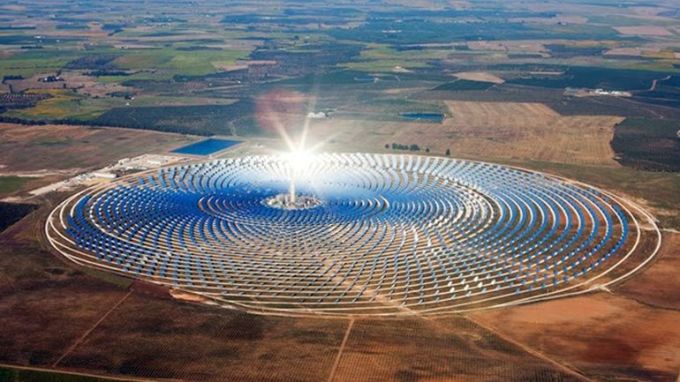
Yet another reason why they only take pictures of Giza from one angle.
2015 was a big, big year for solar and other renewables, culminating in the Paris Climate Deal (one hopes). During the frenzied intensity of the Paris talks one nation emerged as primary antagonist to any climate accord: Saudi Arabia. The rationale for this obstructionism is straightforward: as the world’s archetypal petrostate, Saudi Arabia’s economic future depends upon the world’s continuing carbon addiction.
That said, Saudi Arabia is a fiscally shrewd country existing in an era where renewable power has become increasingly viable. Moreover, Saudi is located in a region whose climate provides unmatched levels of solar power potential. So here is our paradox: what does solar power development look like in a part of the world which sees the technology as both a threat and a godsend?
Three countries stand out when answering this question: one is a petrostate, one is a resource-poor kingdom on the fringes of the Arab world, and the other is the Kingdom of Saud itself.

Solar radiance potential in MENA (in kWh/(m*m))
The Emirates: Business Is Business
Despite the UAE’s overall dependence on fossil fuels in its national economy, the Emirates are aggressive investors in renewable energy, both domestically and internationally. The industry leader here is the Masdar Initiative, a corporate entity owned by Abu Dhabi’s development commission. Its mission statement reads:
We believe that the best way to increase use of clean technologies is to demonstrate that they are commercial viable – to prove that their adoption will not only benefit the health and sustainability of our planet, but will also return profits to our shareholder.

Shams 1, outside Abu Dhabi.
Regardless of how “green” these goals are in relation to, say, the Nature Conservancy, Masdar’s projects have been significant advancements for renewable energy in the Middle East:
- Shams 1: until recently, the world’s largest Concentrated Solar Power* plant, producing 210 GWh/yr, and supplying about .5% of the UAE’s total power needs.
- Tafila Wind Farm: the Kingdom of Jordan’s first utility-scale renewable energy project, with an output of 390 GWh/yr.
- Memorandum of Understanding with Egypt to provide the Egyptian grid with 2 gigawatts’ worth of wind and photovoltaic power (still in development-note that this 2 gW amount is nameplate, not per annum)
- Numerous photovoltaic programs for smaller scale grid independence in Abu Dhabi, Mauritania, and to a smaller degree, in Helmand Province, Afghanistan.
Not to be outdone, the Emirate of Dubai has likewise pledged to adopt a Renewal Portfolio Standard of 15% by 2030, centered on what will be the world’s largest photovoltaic solar facility, in the Emirati desert.
Morocco: Kicking Ass & Planting Mirrors
If the Saudis emerged as antagonists during the Paris climate talks, the Kingdom of Morocco, located at the opposite end of the Arab Middle East, emerged as one of sustainability’s most ambitious champions. In addition to significant land management and reforestation programs, Morocco’s post-Paris climate agenda embraces renewable resources on a staggering scale: by 2025, Morocco aims to meet its energy needs through 50% renewable energy.

Noor-1: 500,000 reflective mirrors heating tubes full of molten salt that can generate electricity for up to three hours after new sunlight has stopped being absorbed.
Morocco will meet these numbers with a combination of wind, hydro, and solar, with solar seen as having the most potential. The centerpiece of this is the Noor-1 Concentrated Solar Plant, which recently supplanted Abu Dhabi’s Shams-1 as the world’s largest CSP facility, with a nameplate capacity (the amount of energy a facility can produce at any one time) of approximately 160 mW/h. Once this four-stage project is complete, its nameplate capacity will be 580 mWh, which will not only meet Morocco’s needs, but also enable the kingdom to pursue options like selling excess energy to its African neighbors.
In a perfect world, Morocco’s prodigious solar output would link up to the energy-hungry economies of Europe, but this goal has repeatedly run into complications. Nevertheless, Morocco remains committed to expanding its renewable portfolio. One of the reasons for this persistence is the fact that Morocco’s flagship project, Noor, still has one extremely serious investor: ACWA, Saudi Arabia’s largest utility corporation. Even while negotiations with Europeans were floundering, Morocco’s solar commission tapped ACWA to implement 350 mW worth of power production in Noor-2 and Noor-3.
So now we have come full circle, back to the Saudis and their ambivalent role in both supporting and resisting the potential of renewable energy sources. In the next entry, we will attempt to reconcile these conflicting strategies.
* How Concentrated Solar Power production works:
Most western readers will be most familiar with solar power as a product of photovoltaic cells, which use sunlight to produce a chemical reaction in synthetic paneling that produces DC electricity which flows onto an electrical grid. Concentrated Solar Power works quite a bit differently:

The sun bounces off an array of mirrors, which reflect the light back towards a central heating tower. This tower is circulating a semi-solid form of salt or other pure chemical extract. The intense solar heat renders this semi-solid molten, and the molten material is pumped through the CSP’s piping system, where it superheats water into steam, which then spins turbines and produces electricity much as one would find in a traditional carbon-burning power facility.
